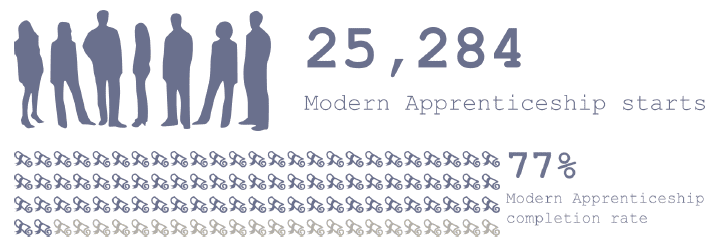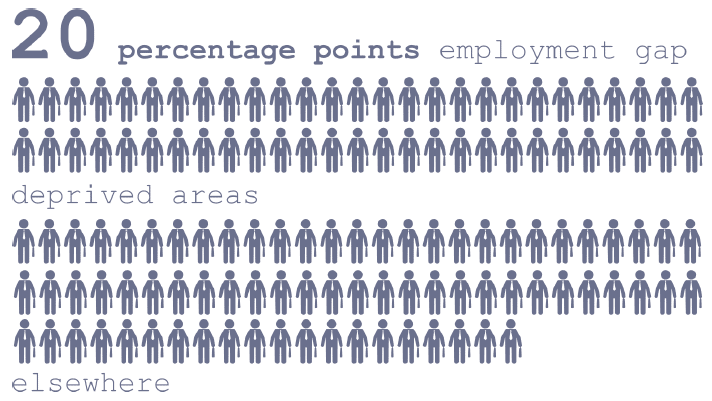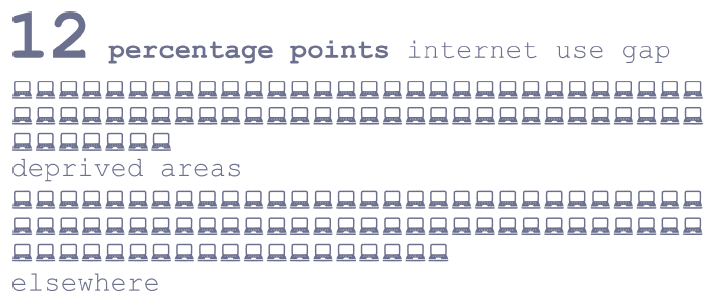Child Poverty Measurement Framework - The Wider Evidence Base
The paper presents the wide range of data collected as part of the process of developing the measurement framework for Scotland’s Child Poverty Strategy presented in the 2014 Annual Report on Child Poverty. Alongside a more detailed analysis of the headline indicators, data is presented from sources considered for inclusion, but not included, in the measurement framework.
4. CHILDREN FROM LOW INCOME HOUSEHOLDS LIVE IN WELL-DESIGNED, SUSTAINABLE PLACES
4.1. The indicators under the 'places' outcome are intended as measures of the characteristics of the areas in which children grow up, rather than the characteristics of the children or their families themselves. Findings are therefore presented for the 15 per cent most deprived SIMD areas as a whole, and are not narrowed down to households with children.
Intermediate outcome 9: Children from low income households live in high quality, sustainable housing

4.2. The first indicator for this outcome in the measurement framework is the ratio of housing costs to income, which was included as a measure of the affordability of housing. Analysis shows that, on average, households in Scotland spend 9.8 per cent of their combined post-tax income on housing.[54]
4.3. Data is also available on overcrowding. This shows that in 2012, 5 per cent of households in the 15 per cent most deprived areas were overcrowded under the bedroom standard, compared to 2 per cent elsewhere.[55]
4.4. A measure of accessibility of housing for the most vulnerable individuals and families is the percentage of homeless households that were entitled to settled accommodation. In 2012/13 this percentage was 95.7 per cent.[56]

4.5. The headline indicator for this outcome, satisfaction with the condition of the home, represents a proxy for housing quality. In 2012, 69 per cent of adults living in the 15 per cent most deprived SIMD areas were satisfied with the condition of their home. This is substantially lower than adults in the rest of Scotland (82 per cent). Similarly, 84 per cent of people in the most deprived areas are satisfied with their home generally, compared to 93 in the rest of Scotland.[57]
4.6. In the same year, in the 15 per cent most deprived areas 63 per cent of dwellings had disrepair to critical elements, and 41 per cent met the Scottish Housing Quality Standard (SHQS), a composite measure of housing quality providing a 'floor' below which a property should ideally not fall. The equivalent figures for the rest of Scotland are not statistically significantly different at 60 per cent and 48 per cent respectively.[58]
4.7. Information is also available on fuel efficiency, where dwellings in deprived areas tend to perform slightly better than those in the rest of Scotland. The SAP 2005 rating is a general rating based on the energy costs associated with space heating, water heating, ventilation and lighting on a scale from 1 to 100 where higher numbers indicate better efficiency. In 2012, the rating score was 68 in the 15 per cent most deprived areas and 63 in the rest of Scotland[59]. A possible explanation is that deprived areas are often also areas with high levels of social housing, and social housing energy efficiency has been regulated upwards, while social housing also tends to be newer and therefore more energy efficient.
4.8. The fuel poverty rate, defined as where the household needs to spend 10 per cent or more of income on fuel use in order to heat the dwelling to an acceptable standard is 29 per cent in the 15 per cent most deprived areas, compared to 27 per cent in the rest of Scotland.[60] This difference is not statistically significant.
Intermediate outcome 10: Children from low income households grow up in places that are socially sustainable
Community engagement and interaction

4.9. The first headline indicator for this outcome looks at community engagement and influence in decision making. In 2012, 21 per cent of adults in the 15 per cent most deprived areas agreed that they could influence decisions affecting their local area. The figure for the rest of Scotland is 24 per cent, which is not a statistically significant difference.[61]

4.10. The second headline indicator looks at community interactions and supportiveness from the perspective of children. In 2010, 63.8 per cent of 13 and 15 year olds living in in the 15 per cent most deprived SIMD areas agreed that people in their area say hello and talk to each other in the street. In the rest of Scotland, this percentage was substantially higher at 76.4 per cent.[62]
4.11. Data is also available for related measures of community support and trust from a children's perspective. In 2010, 64.9 per cent of 13 and 15 year olds living in in the 15 per cent most deprived SIMD areas said that they could ask for help or a favour from neighbours. Again this is substantially lower than the percentage elsewhere (72.8 per cent).[63]
4.12. There are also very large differences in trust. In the 15 per cent most deprived area, 38.6 per cent of 13 and 15 year olds agreed that they could trust people in their local area, very substantially lower than the 68.5 per cent in the rest of Scotland. Similarly, 29.8 per cent of 13 and 15 year olds in the deprived areas and only 16.3 per cent elsewhere agreed that people would take advantage of them if they got the chance[64].
4.13. Other relevant measures look at neighbourhood problems. In 2012 in the 15 per cent most deprived areas, 18 per cent reported that noisy neighbours or loud parties were common, compared to 9 per cent elsewhere, and 9 per cent said neighbourhood disputes were common, compared to 4 per cent elsewhere[65].

4.14. The final two headline indicators under the socially sustainable places outcome focus on communities being safe. Looking at experience of crime, in 2012/13, 21.3 per cent of adults in the 15 per cent most deprived SIMD areas were victims of one or more crimes. This is higher than the adults living in the rest of Scotland (16.1 per cent)[66].

4.15. An indicator is also included on perceptions of crime and anti-social behaviour occurring in the local area. In 2012, 34 per cent of people in the 15 per cent most deprived areas said that drug misuse or dealing were common in their area, very substantially higher than in the rest of Scotland (9 per cent).[67]
4.16. There are a number of related anti-social behaviour measures. In the 15 per cent most deprived areas in 2012, 13 per cent said vandalism, graffiti or damage to property was common, 8 per cent said groups or individual harassing others was common and 18 per cent said rowdy behaviour was common. The equivalent figures for the rest of Scotland are lower at 5 per cent, 3 per cent and 10 per cent respectively.[68]
4.17. In terms of perceptions of safety, 66 per cent of adult in the 15 per cent most deprived areas said they felt very or fairly safe walking alone in their neighbourhood at night, notably lower than in people in the rest of Scotland (85 per cent).[69]
4.18. Perceptions of safety measures are also available from a children's perspective, and also show a large difference between the most deprived areas and elsewhere. In 2010, 75.7 per cent of 13 and 15 year olds in the 15 per cent most deprived SIMD areas felt safe in their local area most or all of the time, compared to 91 per cent in the rest of Scotland, while 63.6 per cent thought it was safe for younger children to play outside, compared to 82.9 per cent in the rest of Scotland.[70]
4.19. Data is also available on perceptions of changes in crime generally. In 2012/13, 72 per cent of adults living in the 15 per cent most deprived areas perceive the crime rate in their local area to have stayed the same or reduced in the past two years. This is slightly lower than the adults living in the rest of Scotland (76 per cent)[71].
Intermediate outcome 11: Children from low income households grow up in places that are physically sustainable

4.20. The first indicator included in the measurement framework under the physical sustainability outcome considers general satisfaction with neighbourhoods. In 2012, 80 per cent of adults from the 15 per cent most deprived SIMD areas thought that their neighbourhood was a good place to live, substantially lower than the rate in the rest of Scotland (96 per cent)[72].

4.21. Satisfaction data is also available for particular aspects of neighbourhoods. The headline indicator included in the measurement framework focuses on public transport as a key public service, which also has an important influence on the economic sustainability outcome through improving physical access to employment opportunities in other areas. In 2012, 76 per cent of adults in the 15 per cent most deprived SIMD areas were satisfied with the quality of local public transport. This is slightly higher than in the rest of Scotland (71 per cent). A possible explanation for this difference is that the majority of the most deprived areas are urban areas, which tend to report higher levels of public transport satisfaction.[73]
4.22. Another relevant measure is satisfaction with community centres and facilities. In 2012, 66 per cent of people in the 15 per cent most deprived areas were satisfied. There was no statistically significant difference to people in the rest of Scotland (70 per cent).

4.23. The final headline indicator included in the measurement framework for this outcome relates to the environmental quality of public spaces. In 2012, 59 per cent of adults in the 15 per cent most deprived SIMD areas could access green space within a six minute walk. In the rest of Scotland, this percentage was substantially higher at 72 per cent.[74]
4.24. Information available on the physical characteristics of neighbourhood also shows that in 2012, 28 per cent of people in the 15 per cent most deprived areas reported rubbish or litter lying about, and 34 per cent reported animal nuisance such as noise or dog fouling, higher than in the rest of Scotland (20 per cent and 34 per cent respectively).[75]
Intermediate outcome 12: Children from low income households grow up in places that are economically sustainable
4.25. The indicators under the economic sustainability outcome measure inequality between areas, by looking at the gap between the outcomes of all adults living in the 15 per cent most deprived SIMD areas and the outcomes for people in the rest of Scotland.

4.26. The first headline indicator in the measurement framework looks at the employment rate. In 2012, the gap between the 15 per cent most deprived SIMD areas and the rest of Scotland was 19.6 percentage points, from 53.8 per cent in the most deprived areas to 73.4 per cent elsewhere.[76]

4.27. The second headline indicator considers those with low or no qualifications. In 2012, the gap between the most deprived areas and the rest of Scotland was 15.9 percentage points, from 26.7 per cent of people having qualifications at SCQF level 4 or below in the 15 per cent most deprived areas, compared to 10.8 per cent elsewhere.[77]
4.28. Related to this, the gap for post-school qualifications (HND or above) was 21.9 per cent in 2012, between 20 per cent in the 15 per cent most deprived areas and 41.9 per cent elsewhere.[78]

4.29. The final headline indicator for the economic sustainability outcome is personal internet use, included as a proxy for digital infrastructure. In 2012, the gap was 12 percentage points, with 67 per cent of people in the 15 per cent most deprived areas using the internet for personal use, compared to 79 per cent elsewhere.[79]
Contact
Email: Franca MacLeod
There is a problem
Thanks for your feedback